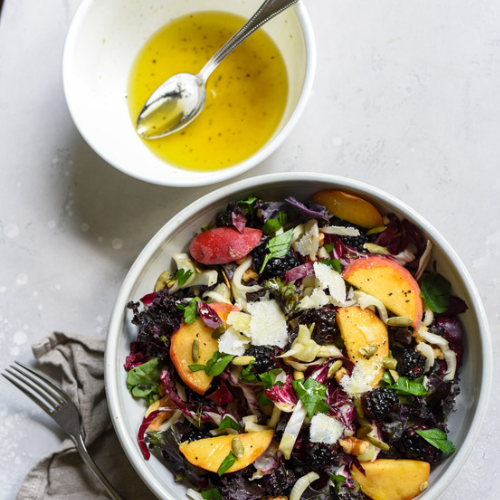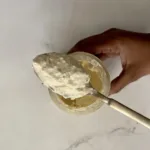One of the easiest ways to make a salad or vegetable dish pop is to use a vinaigrette that is bursting with fresh, bold flavors. The science of making vinaigrettes is pretty simple, but fascinating all the same. And once you’ve mastered the basic ingredients and ratios, you are one step closer to creating unique vinaigrettes right at home!
What is a vinaigrette?
A vinaigrette is made by mixing oil with something acidic such as vinegar. It is used most commonly as a salad dressing, but can also be used as a marinade for vegetables and/or proteins such as fish.
A vinaigrette is technically complete once vinegar and oil are whisked (or shaken) together. This is called an emulsion. Temporary emulsions will bond temporarily (go figure) then then will separate eventually. While a basic vinegar and oil combo will play nice long enough to dress your salad, there are endless ways to enhance both the texture and flavor of your homemade vinaigrettes.
The parts of a vinaigrette
The recommended ratio of oil to vinegar is 3:1. For more punch, a 2:1 ratio can be used as a base. From there, other ingredients can be added to adjust the texture and flavor.
A more developed vinaigrette will be constructed as follows:
3 parts oil +
1 part vinegar +
1/3 part emulsifier +
1/3 to 1/2 part other flavoring ingredients
You can’t make a good vinaigrette without vinegar. It’s as simple as that. Vinegar adds acidity, punch, and flavor to your dressing.
Oil gives the vinaigrette a smooth, pleasant mouthfeel. The oil helps the final dressing really coat and cling to the leaves, tomatoes, vegetables, nuts, carrots, etc. that make it into your salad bowl.
Emulsifiers have a unique function in vinaigrettes.
Other flavors include but absolutely are not limited to sweeteners, allums, herbs, and spices. The flavor of your vinaigrette is only limited by your imagination and access to ingredients.
Ingredient #1: Oil
Light- and neutral-flavored oils are best, but honestly, almost any non-animal fat/oil will do. Some standards include corn oil, grapeseed oil, or avocado oil for a mild base, or use your best extra-virgin olive oil for some grassier undertones.
Try out more flavored oils like sesame oil, walnut oil, or peanut oil for even more complexity.
Ingredient #2: Vinegar/Acid
Some of the more popular kinds of vinegar to use for your dressing are red or white wine vinegar, apple cider vinegar, and balsamic vinegar. Other options include rice wine vinegar, sherry vinegar, or even champagne.
If using citrus as your acid, replace just 1/3 to 1/2 of the vinegar with the juice of a lemon, orange, lime, or grapefruit. You can also add some zest for even more of that bright, citrus flavor.
Ingredient #3: Emulsifier
The handiest emulsifier is a whole-grain mustard. A tiny bit of dijon mustard will help bind the oil and vinegar together in a more consistent vinaigrette.
Whole grain mustards are coated in a substance that binds with both vinegar and oil. While vinegar and oil by themselves will separate eventually, the mustard grabs them both and holds them tight in a nice delicious vinaigrette bear hug.
Don’t worry about there being a strong mustard flavor. You aren’t adding enough (proportionately) to really taste it, but it does a LOT for the texture of the vinaigrette, so don’t skip it if you can help it.
Other emulsifiers include tomato paste, honey, egg yolk, tahini, and miso paste, so if those fit better with the flavor profile you’re going for, try those instead! It’s important to note that some of these like mustard and egg yolk emulsify better than others.
Ingredients #4-7: Extra Flavors
Like the emulsifier, these ingredients are optional; however, they add so many delicious layers to your dressing that it’s worth the time it takes to try out a few different combinations to see which are your favorite.
Sweeteners
To balance out all of the sourness and acidity, add sweeteners. This is often in the form of white or brown sugar, but honey, maple syrup, and molasses are also options.
Fruit can also be used for both sweetness and flavor. Berries can be mashed and incorporated into vinaigrettes. If you want to remove the seeds, just strain them out before adding the fruit mash to the rest of the vinaigrette. For larger fruits, use a food processor or blender to turn the fruit into a puree.Then add the puree into the vinaigrette a little bit at a time, until you’re happy with the taste.
Allums
Onions, shallots, garlic, leeks, chives, and the list goes on. These ingredients and other aromatics really pack a punch. Because they’ll most likely be added to the dressing raw, make sure to dice them into the smallest pieces you can manage. Feel free to use a food processor to help achieve stress-free and consistent results.
Herbs
Fresh herbs like basil and mint really pack a punch when they are chopped and added to the dressing. Thyme and rosemary can add a subtle earthiness. Experimenting with fresh elements will leave you with dressings that are light and refreshing.
Spices
Spices refers to any dried flavoring whether it’s adds spice that clears your sinuses and makes you sweat or not. Cinnamon and nutmeg are spices that aren’t necessarily spicy.
Dried pepper flakes, dried ground ginger, or cayenne pepper could be added to add some actual tongue-torching heat to your dressing. Be careful not to add too much at first. Add a little at a time and taste to adjust.
Deciding how much vinaigrette to make
A good rule of thumb for vinaigrettes is to use 1.5 to 2 tablespoons of dressing per person or per serving of salad. For example, to make enough dressing for two salads, make about 4 tablespoons of dressing. Using the ratios above, this translates to roughly:
- 1 tablespoon of vinegar
- 3 tablespoons of oil
- 1/3 tablespoon of mustard
- 1/3 to 1/2 tablespoons of other flavors (sugar, shallots, citrus juice, etc.)
Do I have to use *exact* measurements?
NO! You can “eyeball” every single vinaigrette you make. No measuring spoons necessary.
The most important thing is getting the ratios close to right. So if you have 1 tablespoon of vinegar, use 3 tablespoons of oil, 1/3 tablespoon of emulsifier, and 1/3 to 1/2 tablespoon of other flavoring ingredients.
Tools needed to make vinaigrette
A bowl with high sides will help keep your vinaigrette in the bowl and off the kitchen counters.
A whisk is the most efficient utensil to break up the molecules of the oil, vinegar, emulsifier, etc. and force them to bond and play nice.
If you don’t have a whisk, use a mason jar or some other container with a lid that you can screw on tight. Just eyeball or measure the ingredients into the jar, close, and shake vigorously for 20 to 30 seconds.
Things to keep in mind
- Granular ingredients like salt and sugar dissolve much easier before the oil gets involved, so, if you’re adding a bit of salt (and you should) add that to the vinegar base before mixing the oil and vinegar together.
- Any fruits with seeds can be strained before adding the pulp to the finished dressing. This will result in a smoother texture.
- The order you add the ingredients in matters: mix granular ingredients with oil then add the emulsifier and any other flavoring ingredients. Lastly, slowly drizzle in the oil as you whisk. If using the jar method, combine everything except the oil, cover and shake then add the oil, cover and shake until combined.
How to store homemade vinaigrette
Store vinaigrettes in an airtight jar or container with a lid so that it can be shaken before each use. Most homemade vinaigrettes, because they contain vinegar and other strong acids that help preserve the dressing, will last 3 to 4 weeks minimum in the refrigerator.
They can last up to several week though, so conduct a sniff test before throwing away any perfectly good vinaigrette. If it smells off or different from when it was first made, just pour it out and whip up a new batch.


